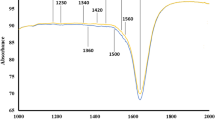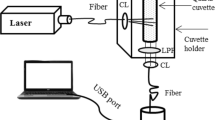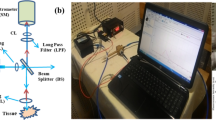Abstract
We report here a study on human saliva tested as a diagnostic medium for oral cancer detection on three groups: oral squamous cell carcinoma (OSCC), oral sub mucous fibrosis (OSMF; precancer), and healthy controls (normal). Measurements have been conducted using fluorescence spectroscopy with 350 nm excitation and Stokes shift (SS) spectroscopy (SSS) with 120 nm shift from a total of 99 saliva samples. For classification, principal component analysis (PCA) and linear discriminant analysis (LDA) have been applied on the data sets. Linear discriminant (LD) scores of fluorescence spectra are able to differentiate OSCC to normal, OSMF to normal and OSCC to OSMF with sensitivities 91%, 92%, 91% and specificities 97%, 100%, 94% respectively, while LD scores of SS spectra differentiate respective groups with sensitivities 100%, 94%, 94% and specificities 97%, 100%, 94%. Cross-validation on the datasets of PC scores during LDA illustrates that sensitivity and specificity of SSS data are less affected than those of fluorescence data. Saliva is thus seen as a potential non-invasive and simple diagnostic medium, with SS spectroscopy as a better diagnostic tool for oral precancer.








Similar content being viewed by others
References
Neville BW (2002) Oral cancer and precancerous lesions. CA Cancer J Clin 52:195–215
Yardimci G, Kutlubay Z, Engin B, Tuzun Y (2014) Precancer lesions of oral mucosa. World J Clin Cases 2(12):866–872
Hazarey VK, Erlewad DM, Mundhe KA, Ughade SN (2007) Oral submucous fibrosis: study of 1000 cases central India. J Oral Path Med 36:7–12
Varshitha A (2015) Prevalence of oral cancer in India. J Pharm Sci Res 7(10):845–848
Dikshit R, Gupta PC, Ramasundarahettige C et al (2012) Cancer mortality in India: a nationally representative survey. Lancet 379:1807–1816
Chaturvedi AK, Anderson WF, Tieulent JL et al (2013) Worldwide trends in incidence rates for oral cavity and oropharyngeal cancers. J Clin Oncol 31(36):4550–4559
Scully C, Bagan JV, Hopper C, Epstein JB (2008) Oral cancer: Current and future diagnostic techniques. Am J Dent 21(4):199–209
Fedele S (2009) Diagnostic aids in the screening of oral cancer. Head Neck Oncol 1:1–5
Wang CY, Chiang HK, Chen CT, Chiang CP, Kuo YS, Chow SN (1999) Diagnosis of oral cancer by light-induced auto fluorescence spectroscopy using double excitation wavelengths. Oral Oncol 35:144–150
Omar EA (2015) Current concepts and future of noninvasive procedures for diagnosing oral squamous cell carcinoma-a systematic review. Head Face Med 11:6
Pichardo JL, García OB, Franco MR, Juarez GG (2007) Raman spectroscopy and multivariate analysis of serum samples from breast cancer patients. Lasers Med Sci 22:229–236
De Veld DC, Witjes MJ, Sterenborg HJ, Roodenburg JL (2005) The status of in vivo autofluorescence spectroscopy and imaging for oral oncology. Oral Oncol 41:117–131
Schantz SP, Kolli V, Savage (1998) In vivo cellular fluorescence and histological characteristics of head and neck cancer. Clin Cancer Res 4:1177–1182
Ramanujam N, Mitchell MF, Jansan AM et al (1996) Cervical precancer detection using a multivariate statistical algorithm based on laser-induced fluorescence spectra at multiple excitation wavelengths. Photochem Photobiol 64(4):720–735
Lane PM, Gilhuly T, Whitehead P et al (2006) Simple device for the direct visualization of oral-cavity tissue fluorescence. J Biomed Opt 11(2):024006
Inaguma M, Hashimoto K (1999) Porphyrin-like fluorescence in oral cancer. Cancer 86(11):2201–2211
Alfano RR, Lam W, Zarrabi HJ, Alfano MA, Cordero J, Tata DB, Swenberg CE (1984) Human teeth with and without caries studied by laser scattering, fluorescence, and absorption spectroscopy. IEEE J Quantum Electron 20(12):1512–1516
Alfano RR, Tang GC, Pradhan A, Lam W, Choy DSJ, Opher E (1987) Fluorescence spectra from cancerous and normal human breast and lung tissues. IEEE J Quantum Electron 23(10):1806–1811
Vo-Dinh T (1978) Multicomponent analysis by synchronous luminescence spectroscopy. Anal Chem 50(3):396–401
Majumder SK, Gupta PK (2000) Synchronous luminescence spectroscopy for oral cancer diagnosis. Lasers Life Sci 9:143–152
Rajasekaran R, Aruna P, Koteeswaran D, Baludavid M, Ganesan S (2014) Synchronous luminescence spectroscopic characterization of urine of normal subjects and cancer patients. J Fluoresc 24(4):1199–1205
Devi S, Ghosh N, Pradhan A (2015) A technique for correction of attenuations in synchronous fluorescence spectroscopy. J Photochem Photobiol 151:1–9
Alfano RR, Yang Y (2003) Stokes shift emission spectroscopy of human tissue and key molecules. IEEE J Sel Top Quantum Electron 9:148–153
Ebenezar J, Aruna P, Ganesan S (2010) Synchronous fluorescence spectroscopy for the detection and characterization of cervical cancers in vitro. J Photochem Photobiol 86:77–86
Pu Y, Wang W, Yang Y, Alfano RR (2012) Stokes shift spectroscopy highlights of cancerous and normal human tissues. Optical Letters 37(16):3360–3362
Schmidt B, Engel E, Carstensen T, Weickmann S, John M, Witt C (2005) Quantification of free RNA in serum and bronchial lavage: a new diagnostic tool in lung cancer detection? Lung Cancer 48:145–147
Bryzgunova OE, Skvortsova TE, Kolesnikova EV et al (2006) Isolation and comparative study of cell-free nucleic acids from human urin. Ann NY Acad Sci 1075:334 – 40
Markopoulos AK, Michailidou EZ, Tzimagiorgis G (2010) Salivary markers for oral cancer detection. Open Den J 4:172–178
Wu JY, Chen Y, Chung HR et al (2010) Potential biomarkers in saliva for oral squamous cell carcinoma. Oral Oncol 46:226–231
Harris AT, Lungari A, Needham CJ et al (2009) Potential for Raman spectroscopy to provide cancer screening using a peripheral blood sample. Head Neck 1:34
Kuznetsov A, Frorip A, Maiste A, Rosenberg MO, Sünter A (2015) Visible auto-fluorescence in biological fluids as biomarkers of pathological process and new monitoring tool. J Innov Opt Health Sci 8(3):1541003
Soukos NS, Crowley K, Bamberg MP, Gillies R, Doukas AG, Evans R, Kollias N (2000) A rapid method to detect dried saliva stains swabbed from human skin using fluorescence spectroscopy. Forensic Sci Int 114:133–138
Virkler K, Lednev IK (2009) Analysis of body fluids for forensic purposes: From laboratory testing to non-destructive rapid confirmatory identification at a crime scence. Forensic Sci Int 188:1–17
Hossein FA, Dizgah IM, Rahimi A (2009) Correlation of serum and salivary CA15–3 levels in patients with breast cancer. Med Oral Patol Oral Cir Bucal 14(10):521–524
Xiaozhou L, Yang T, Lin J (2012) Spectral analysis of human saliva for detection of lung cancer using surface-enhanced Raman spectroscopy. J Biomed Opt 17(3):037003
Yuvaraj M, Udayakumar K, Jayanth V et al (2014) Fluorescence spectroscopic characterization of salivary metabolites of oral cancer patients. J Photochem Photobiol 130:153–160
Patil A, Choudhari KS, Unnikrishnan VK et al (2013) Salivary protein markers: a noninvasive protein profile-based method for the early diagnosis of oral premalignancy and malignancy. J Biomed Opt 18(10):101317
Nagler R, Bahar G, Shpitzer T, Feinmesser R (2006) Concomitant analysis of salivary tumor markers – A new diagnostic tool for oral cancer. Clin Cancer Res 12(13):3979–3984
Devi S, Panigrahi PK, Pradhan A (2014) Detecting cervical cancer progression through extracted intrinsic fluorescence and principal component analysis. J Biomed Opt 19(12):127003
Mazanec J, Melisek M, Pavlovicova J (2008) Support vector machines, PCA and LDA in face recognition. J of Electrical Engineering 59(4):203–209
Silverman BW (1986) Density estimation for statistics and data analysis. J Appl Probab Stat 30(7):175
Al-Thunayan MA (2006) Cancer diagnosis by synchronous fluorescence spectra of blood and urine components. Phd thesis, King Saud University
Acknowledgements
We thank to Dr. Shivani Nautiyal and Dr. Kumar Ashutosh for helping in saliva collection.
Author information
Authors and Affiliations
Corresponding author
Ethics declarations
Conflict of Interest
The authors have no relevant financial interests in this article and no potential conflicts of interest to disclose.
Rights and permissions
About this article
Cite this article
Kumar, P., Singh, A., Kumar Kanaujia, S. et al. Human Saliva for Oral Precancer Detection: a Comparison of Fluorescence & Stokes Shift Spectroscopy. J Fluoresc 28, 419–426 (2018). https://doi.org/10.1007/s10895-017-2203-2
Received:
Accepted:
Published:
Issue Date:
DOI: https://doi.org/10.1007/s10895-017-2203-2




